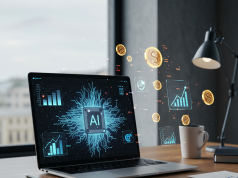Generative AI is rapidly transforming the way marketing teams create, distribute, and optimize campaigns. By leveraging advanced machine learning models, brands can produce personalized content at scale, automate tedious design tasks, and respond to customer interactions in real time. In this guide, we dive into the key techniques, tools, and performance metrics you need to harness generative tools effectively in 2025. Whether you’re aiming to boost ROI, streamline workflows, or innovate customer experiences, you will find actionable insights to drive your AI-driven marketing strategy forward.
Understanding Generative AI in Marketing

At its core, generative AI refers to algorithms that can create text, images, video, or audio based on learned patterns from existing data. In marketing, these tools enable dynamic ad copy generation, on-brand visuals, and personalized product recommendations. Unlike traditional automation, generative models adapt to variations in tone, context, and audience preferences, resulting in more engaging outputs. Key technologies include large language models (LLMs) for text generation and diffusion or GAN architectures for imagery. As these systems continue to advance, marketers gain new capabilities to test creative concepts faster and at lower cost than ever before.
Key Benefits of Generative Tools
- Scalability: Produce large volumes of personalized content without proportionally increasing headcount.
- Speed to Market: Accelerate campaign ideation, A/B testing, and revisions with AI assistance.
- Cost Efficiency: Reduce outsourcing fees for design, copywriting, and video editing.
- Consistency: Maintain brand voice and style guidelines across all generated assets.
- Innovation: Explore novel, creative directions that would be hard to conceive manually.
Top Generative AI Tools for Marketing in 2025
Choosing the right generative tool depends on your specific use case, technical resources, and budget. Here are the leading platforms to consider this year:
- OpenAI’s GPT-4 Turbo – Industry-leading LLM for high-quality copywriting, chatbots, and email automation.
- Midjourney v6 – State-of-the-art image generation for banner ads, social posts, and mood boards.
- RunwayML Gen-2 – Video creation and editing accelerated by AI for dynamic social media reels.
- DALL·E 3 – Versatile visual asset production with improved text-to-image controls.
- Jasper AI – Marketing-oriented copy assistant with templates for ads, blogs, and landing pages.
Implementation Strategies
Integrating generative AI into your marketing stack requires careful planning. Start by defining clear objectives such as improving click-through rates or reducing content creation time. Next, pilot one or two high-impact use cases with a cross-functional team of marketers, designers, and data analysts. Monitor performance metrics closely and iterate on prompts or creative parameters. Invest in training sessions to upskill your team on AI best practices and governance policies. Finally, establish a feedback loop where human editors review AI outputs for quality, brand alignment, and compliance before publishing.
Crafting AI-Driven Campaigns

To create compelling AI-driven campaigns, follow a structured approach:
- Define Your Audience – Segment users by behavior, demographics, and purchase history for targeted personalization.
- Develop Core Messages – Use generative tools to draft multiple headline and body variations quickly.
- Design Visual Assets – Generate background images, product renders, or abstract graphics that match your brand palette.
- A/B Test at Scale – Deploy dozens of ad variants automatically and let AI optimize budget allocation in real time.
- Automate Follow-Ups – Trigger personalized emails or chatbot messages based on user engagement signals.
Measuring ROI and Performance Metrics
Tracking the success of AI-powered marketing requires both traditional and AI-specific KPIs. Beyond click-through rate (CTR) and conversion rate, monitor metrics like:
- Engagement Lift: Compare user interactions before and after AI implementation.
- Time Saved: Quantify hours recovered from automated content generation tasks.
- Cost Per Asset: Calculate savings relative to traditional agency or in-house production.
- Creative Diversity Index: Measure the variety of styles and messages produced by AI vs manual efforts.
- Brand Consistency Score: Use AI tools to detect style deviations across channels.
Real-World Case Studies
Leading brands are already demonstrating the power of generative tools:
- E-Commerce Retailer – Increased email campaign conversions by 35% using AI-generated product descriptions and dynamic imagery.
- Global Financial Services Firm – Reduced ad creative turnaround time by 60% while maintaining strict compliance through AI-driven review workflows.
- Health & Wellness Brand – Launched personalized social media ads that boosted engagement by 50% using generative video snippets created in minutes.
Best Practices and Common Pitfalls
To maximize success with generative tools, follow these best practices and avoid typical missteps:
- Best Practice: Establish clear brand guidelines for tone, style, and imagery to ensure consistency.
- Pitfall: Overreliance on AI outputs without human review can lead to off-brand or inaccurate copy.
- Best Practice: Organize assets and prompts in a shared repository for repeatable workflows.
- Pitfall: Neglecting data privacy and copyright considerations when training or fine-tuning models.
- Best Practice: Continuously retrain and update models with fresh data to maintain relevance.
Future Outlook for Generative Marketing
As generative AI continues to evolve, marketers can expect even deeper integrations across omnichannel experiences. AI will be able to generate entire customer journeys end to end, seamlessly adapting content based on real-time sentiment analysis and predictive behavior modeling. We may also see tighter integrations between generative tools and CRM systems, enabling fully automated personalization at scale. Staying informed about emerging algorithms and ethical frameworks will be critical for brands that want to lead in this next phase of marketing innovation.
Conclusion
Generative AI tools offer unparalleled opportunities to enhance creativity, efficiency, and ROI in marketing campaigns. By adopting the right platforms, implementing structured processes, and focusing on measurement and governance, brands can unlock significant competitive advantages in 2025 and beyond. Start small with pilot projects, build internal expertise, and scale successful use cases across your organization. With the strategies outlined in this guide, you’re equipped to supercharge your marketing efforts and achieve remarkable results with generative AI.
As AI continues to evolve, many businesses are adopting custom generative AI solutions for niche industries to solve highly specific challenges.







